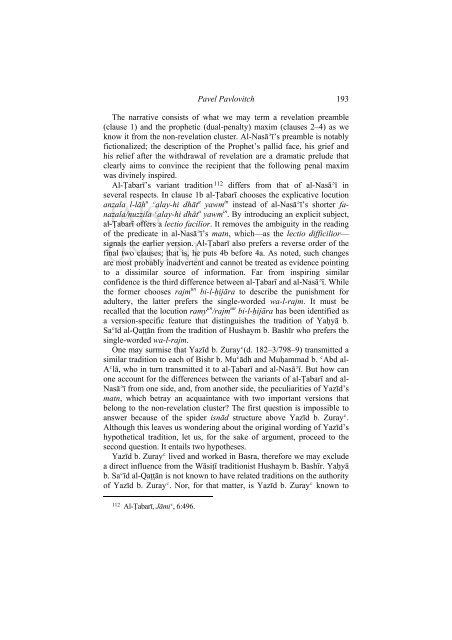JOURNAL OF ARABIC AND ISLAMIC STUDIES
JOURNAL OF ARABIC AND ISLAMIC STUDIES
JOURNAL OF ARABIC AND ISLAMIC STUDIES
You also want an ePaper? Increase the reach of your titles
YUMPU automatically turns print PDFs into web optimized ePapers that Google loves.
JAIS<br />
ONLINE<br />
Pavel Pavlovitch<br />
The narrative consists of what we may term a revelation preamble<br />
(clause 1) and the prophetic (dual-penalty) maxim (clauses 2–4) as we<br />
know it from the non-revelation cluster. Al-Nasāʾī’s preamble is notably<br />
fictionalized; the description of the Prophet’s pallid face, his grief and<br />
his relief after the withdrawal of revelation are a dramatic prelude that<br />
clearly aims to convince the recipient that the following penal maxim<br />
was divinely inspired.<br />
Al-Ṭabarī’s variant tradition 112 differs from that of al-Nasāʾī in<br />
several respects. In clause 1b al-Ṭabarī chooses the explicative locution<br />
anzala l-lāh u ʿalay-hi dhāt a yawm in instead of al-Nasāʾī’s shorter fanazala/nuzzila<br />
ʿalay-hi dhāt a yawm in . By introducing an explicit subject,<br />
193<br />
al-Ṭabarī offers a lectio facilior. It removes the ambiguity in the reading<br />
of the predicate in al-Nasāʾī’s matn, which—as the lectio difficilior—<br />
signals the earlier version. Al-Ṭabarī also prefers a reverse order of the<br />
final two clauses; that is, he puts 4b before 4a. As noted, such changes<br />
are most probably inadvertent and cannot be treated as evidence pointing<br />
to a dissimilar source of information. Far from inspiring similar<br />
confidence is the third difference between al-Ṭabarī and al-Nasāʾī. While<br />
the former chooses rajm un bi-l-ḥijāra to describe the punishment for<br />
adultery, the latter prefers the single-worded wa-l-rajm. It must be<br />
recalled that the locution ramy un /rajm un bi-l-ḥijāra has been identified as<br />
a version-specific feature that distinguishes the tradition of Yaḥyā b.<br />
Saʿīd al-Qaṭṭān from the tradition of Hushaym b. Bashīr who prefers the<br />
single-worded wa-l-rajm.<br />
One may surmise that Yazīd b. Zurayʿ(d. 182–3/798–9) transmitted a<br />
similar tradition to each of Bishr b. Muʿādh and Muḥammad b. ʿAbd al-<br />
Aʿlā, who in turn transmitted it to al-Ṭabarī and al-Nasāʾī. But how can<br />
one account for the differences between the variants of al-Ṭabarī and al-<br />
Nasāʾī from one side, and, from another side, the peculiarities of Yazīd’s<br />
matn, which betray an acquaintance with two important versions that<br />
belong to the non-revelation cluster? The first question is impossible to<br />
answer because of the spider isnād structure above Yazīd b. Zurayʿ.<br />
Although this leaves us wondering about the original wording of Yazīd’s<br />
hypothetical tradition, let us, for the sake of argument, proceed to the<br />
second question. It entails two hypotheses.<br />
Yazīd b. Zurayʿ lived and worked in Basra, therefore we may exclude<br />
a direct influence from the Wāsiṭī traditionist Hushaym b. Bashīr. Yaḥyā<br />
b. Saʿīd al-Qaṭṭān is not known to have related traditions on the authority<br />
of Yazīd b. Zurayʿ. Nor, for that matter, is Yazīd b. Zurayʿ known to<br />
112 Al-Ṭabarī, Jāmiʿ, 6:496.

















